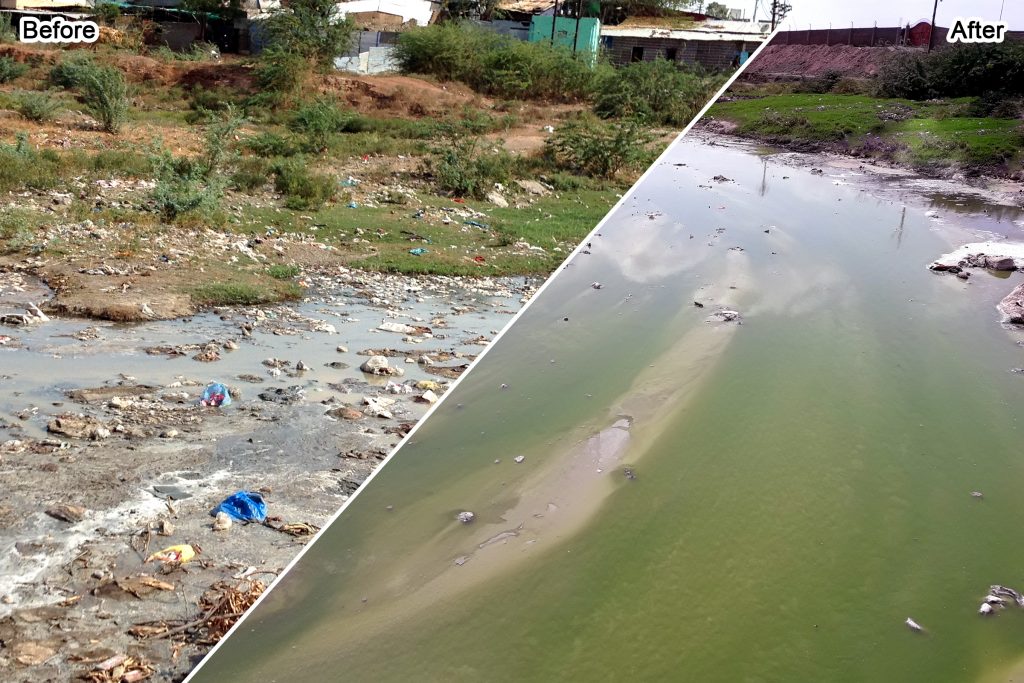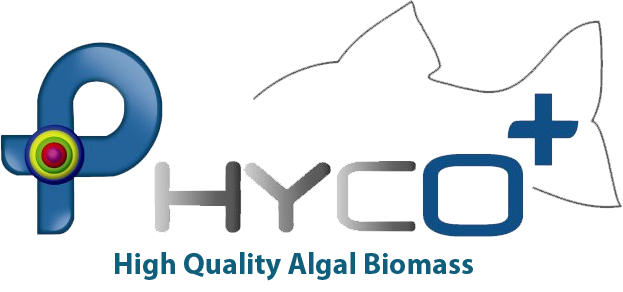

The Technology
Ponds, lakes, rivers and other waster bodies are getting polluted through discharges from agricultural run-off, sewage discharge, industrial effluents etc. Due to excessive loading of chemicals and nutrients (eutrophication) sudden blooming of hazardous algae – mostly blue green algae – occurs, eliminating other species of algae which usually form a part of the natural food chain. Duckweeds or other floating vegetation are also common, cutting off light which results in anaerobic conditions developing in the lower layers, leading to destruction of ecosystems. Water becomes turbid and foul smelling and very high Biochemical oxygen demand (BOD) and chemical oxygen demand (COD) associated with huge populations of coliform bacteria. Restoring these wasted water bodies is a major challenge, and our company, PERC, has recently taken up this challenge and developed a microalgae-based product.
Phycospectrum Environmental Research Centre (PERC), Chennai, has been involved in developing and implementation of microalgae-based treatment technologies for handling industrial effluents in India and abroad. pH correction, color removal, odor removal, COD and BOD reduction, and sludge reduction have been successfully implemented by PERC algal technology.
Present status of restoration process of natural water bodies
Spending enormous money and building sewage treatment plants have not helped cleanse India’s polluted river stretches. The estimated polluted riverine length is 13,000 KMs approximately about 5 times the length of Ganga main stem (Down to Earth, March 2018). A Central Pollution Control Board (CPCB) report of 2015 brought out the fact that 61,948 million litres of urban sewage is generated on a daily basis in India. But the cities have an installed sewage treatment capacity of only 38 per cent of this. In reality more than this amount goes untreated into the rivers or water bodies as the treatment capacity of major sewage treatment plants (STPs) in the country is around 66 per cent of the installed capacity as per CPCB findings of 2013. As a result, more than 38,000 million litres of waste water goes into the major rivers, water bodies and even percolates into the ground every day. Over and above this there is industrial effluent. In October 2017, the Centre planned to focus on bioremediation technologies for cleaning Ganga at 54 new sites. In-situ treatment is simple and easy-to-operate and does not require major modification of the drain, said a note from MOWR (Down to Earth, March 2018).
Algae Power
Micro algae are primitive photosynthetic microscopic simple organisms which evolved on earth 1.4 billion years ago. Being photosythetic micro algae are the starting point of food chain in any aquatic ecosystem called as Primary Producers which are consumed by zooplankton and fish. Micro algae take up atmospheric carbon di oxide for photosynthesis and evolve oxygen. Micro algae also take up nutrients like nitrates, ammonia and phosphate from water for growth and metabolism. Huge number of beneficial symbiotic bacteria associated with these micro algae also help in purification of water by acting upon the organic load utilizing the oxygen released by algae. Through oxygenation of water micro algae can eliminate harmful bacteria and other nuisance algae establishing a normal food chain (Fig 1).
Fig 1. The power of algae
PHYCOPLUS Technology
PERC (Phycospectrum Environmental Research Centre), Chennai has been involved in development and implementation of micro algae based (bio) remediation technologies for the last 2 decades for dealing with industrial waste waters and domestic sewage. PERC in the process has developed a micro algae-based technology assisted by a nanotechnology-based product called PHYCOPLUS for restoring natural water bodies including lakes, drains and rivers. PERC has successfully restored a number of polluted lakes, drains and a river using this eco-friendly in situ technology. CPCB in its latest (June 2019) Indicative guidelines for restoration of water bodies has acknowledged this technology. PHYCOPLUS is composed of micro nutrients, trace elements, growth factors (hormones) and enzymes which facilitate faster restoration of polluted water bodies (Fig 2). Symbiotic association between micro algae and bacteria help in acting up on pollutants and bring about restoration of the aquatic ecosystem to normalcy well assisted by PHYCOPLUS, which enhances the metabolic activities of algae and bacteria. PHYCOPLUS also interferes with nuisance bloom forming cyanobacteria breaking its dominance.
Fig 2 Action of PHYCOPLUS in remediating polluted water bodies
The first CSR project to validate PHYCOPLUS technology
(A CSR Project involving Micro Algae based Chemical Free bio-remediation of contaminated lake in remote village near Aligarh in U.P, India)
This technology has been recently demonstrated by PERC in a village lake near Aligarh, Northern India. This lake received discharge from households of the village and agricultural run-off which contain huge amounts of nutrients and organic loads polluting the lake completely. The lake was covered with floating cyanobacterial mats and duck weeds which prevented light penetration. Water had a foul odor and color was blackish – and the village people almost abandoned this lake.
Fig 3 Polluted lake at Mainath before and after restoration process by employing PHYCOPLUS technology
After PERC’s restoration work the lake water became transparent, COD and BOD reduced to a minimum and there was a significant reduction of coliform bacteria. Floating cyanobacterial mats and duckweeds vanished. Periodic addition of Phycoplus helped maintain the lake from further eutrophication and fouling (Fig 3).
Table 1 Water parameters before and after treatment (2 weeks)
Table 1 reveals the efficiency of PHYCOPLUS technology in restoring the polluted lake within 2 weeks and after 2 application of Phycoplus. More than 90% reduction in BOD and COD. Total coliform bacteria and E coli were eliminated by 99.7%. After 2 or 3 applications a monthly maintenance dose of PHYCOPLUS is recommended.
First ever restoration of a polluted river using PHYCOPLUS technology
Mausam River – Malegaon
India’s first successful river bio-remediation exercise with 90% reduction in contamination levels and results visible over 10 km stretch.
Malegaon is a small city near Nasik in Maharashtra with a population of a little over 500,000. There is no Sewage Treatment Plant in the city, owing to which, the entire untreated sewage of 75 MLD is drained directly into the River Mausam. There is one large industrial unit there in Malegaon which is engaged in bleaching and mercerizing of gray fabric. Semi-treated, industrial effluent of 1.5 MLD capacity is drained directly into the River Mausam.
River Mausam is a seasonal river flowing through the heart of the city of Malegaon. Owing to a barrage just before the River enters the city, the river almost has no fresh water except during the rainy season.
After flowing for almost 10 – 12 kms through the entire city of Malegaon, the river Mausam merges into the River Girna, which eventually merges into the River Tapi.
Samples of the river were collected from from 3 different locations (Table 2):
1. Dyane Bridge (with just industrial effluent and no sewage)
2. Mausam Bridge (after sewage entry)
3. Chandanpuri Bridge (10 kms downstream of inoculation point, after meeting River Girna).
Table 2 . Mausam river parameters before treatment
INTERVENTION IN MALEGAON:
PERC has setup a phycoremediation plant for treating the industry’s effluent. The pH was corrected without chemicals to 8, saving Rs. 1.25 cr per year for the industry. The COD was reduced to less than 300 ppm. The phycoremediation plant doubled up as an algal inoculum manufacturing setup. The micro-algae harvested was stabilized and added to Phycoplus and then let out into the river. The following changes were observed in the river after 3 weeks of treatment (Table 3). Even at 10 Km point of Chandanpuri we could achieve more than 90% reduction in COD.
The way forward:
PERC has been working on other water bodies in India and in Colombia. Phycoplus technology has helped in restoration of a polluted drain and a swamp in Colombia. PERC is also involved in one of the projects of NMCG is restoring a polluted drain in Gulaoti, UP. Recently the team of PERC and Trinity Impex, New Delhi has been awarded a project to restore an acidic river of Meghalaya. The in-situ Bioremediation technology developed by PERC is an advanced nano tech-based process of 2 decades of research and this along with the power of algae can definitely provide a big opportunity to handle some of the worst polluted drains and water bodies and manage them efficiently.
Phycoremediation, is a technology of present and future for waste water treatment and improving environment, being a carbon negative technology
Pollutants that can be removed using Phycoremediation:
Economic Advantage: Almost no Electricity, no harmful chemical and almost no Capital cost (Capex) – Most inexpensive technology compared to benefits (up to 80 % reduction in comparison to STP, ETP and other mechanical technologies). No External bacteria, sustainable technology
Social Advantage: improves quality of ground recharge water, surroundings become oxygen rich, Mosquitoes are driven away, Fish can be cultured in treated water as it is oxygen rich. Improves ecology for bio life. Reduces disease. Treated water is good for crops as it has required nutrition. Reduces GH Gases (Carbon Di Oxide etc) which cause global warming.